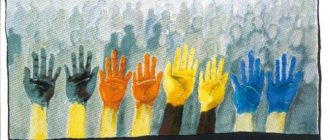Concept of intolerance
It is common for every individual to be hostile towards people whose way of life is radically different from what he is used to. The manifestation of intolerance is most often found in rejection of such human characteristics as:
- behavior;
- character traits;
- beliefs;
- manner of dressing;
- speech culture and others.
Sometimes intolerance towards someone can only cause us negative emotions, but some openly perceive with hostility the characteristics of other people, poisoning their lives. The most unpleasant thing here is that over time, people who are unpleasant to us are given not the most flattering labels. It turns out that intolerance is a universal human quality, which is expressed in denial and rejection of what is unusual for us. Intolerance can manifest itself not only in relation to an individual, but also in relation to entire nations. We often come across condemnation of such features as:
- culture;
- national characteristics;
- religious beliefs.
Elena Meysak
Today I want to talk about such a substance as intolerance towards people.
Those who have known me for a long time most likely also know that I am a supporter of Swiss neutrality in such sensitive issues as politics, religion, financial situation, tastes and preferences. This means that I never discuss these things with anyone except a very narrow circle of like-minded people.
Neutrality is not complete indifference. This is healthy indifference, the ability to stay within your boundaries and not attack a person when you are not asked to do so {and criticism of a request is an attack}. If my interests intersect or conflict in some way, I try to find a compromise, a win-win solution that will suit everyone.
If compromise is not possible, I will choose to give up the fight and give up. Not because I'm a loser and a coward, although sometimes that's too. But because I have already lived long enough in this world to understand where banging my head against the wall for my truth leads.
Two years ago I was sick for 1/4 of a year and spent another year recovering only because the current market denied me something I once really wanted but had a hard time accepting. Therefore, the plane of my life went into a stall, and I think if I had continued to fight so actively with life for the goodies I didn’t receive, this life could have already ended.
I think this was a good warning from life in terms of the fact that it can be different, and if some opportunities do not come your way, it means it is unprofitable for you, dangerous, costly, there are better options, etc. Therefore, if I do not reach a compromise on some issue, it is easier to backtrack.
Because as long as you have life and health, you can make all these good things for yourself again: you can scrape yourself off the asphalt after bankruptcy, start a new relationship, survive betrayal, whatever!
And despite all this, I still have a very hard time with such a thing as intolerance towards people.
For example, today this photograph of me became the subject of controversy.
This is a screenshot of my new video, which will soon appear on my ASMR channel. What kind of channel is this, and why do people dress up like that, I already wrote, I won’t repeat it.
My peaceful proposal not to take the image seriously, but to regard it as a stage play in a movie, was indignantly rejected. Then I received an offer that was almost insulting. Not me, no. Other people based on certain characteristics.
To be honest, sometimes I’m very stupid and I still don’t understand why my interlocutor didn’t like my appearance so much, but now it doesn’t matter. I believe that as long as a person does not violate the law and generally accepted moral and ethical standards, everything else is within the limits of his personal preferences.
That is, how a person dresses, how much he earns per month, when he plans to get married and have children, what time of day is most convenient for him to work - all this should remain within the framework of a particular person. There is no need to pry into his soul and personal boundaries and ask him about the reasons why he does what he wants and not what you want.
By the way, I really like this image, and sometimes I go to the center of Moscow in this form, with the only difference being that I have a black hat on my head instead of a wig, and my nails are not false, but natural, painted black. And one more thing: this is not a rolled-up cigarette in the screenshot, if anyone doesn’t understand, this is Nicorette, a remedy against tobacco addiction. I don't smoke, it was necessary for filming.
And what is completely unacceptable is to consider a person bad because he is unlike you and you do not understand him. And unfortunately, there are more than just a lot of such cases of intolerance towards people due to banal fear and misunderstanding around.
I still can’t understand what it is, well, that’s what it is, when people with two or more higher educations and a lot of life experience begin to discriminate against people on national, religious, gender and other grounds. Here you need to tell yourself again: stop!
The answers to the most difficult questions in life are usually very simple. In life there are only people who break the law and those who do not. All.
Intolerance towards people begins when everything is swimming in a person’s head, and a person turns out to be “bad” according to non-legal criteria.
A person cannot be bad just because he is gay, Muslim, Christian, goth, punk, Scorpio, not a Muscovite, disabled, poor, housewife, night owl, foreigner, vegetarian, “didn’t graduate from university,” etc.
Among all these people there can be both good and bad people. It sometimes amazes me, where does so much intolerance towards people come from?
I like to interpret F. Nietzsche's statements in different ways. Each of his aphorisms can be interpreted not only in direct, but also in many metaphorical meanings.
For example this
“...If you look into the abyss for a long time, then the abyss also looks into you”
There are many hidden meanings in this phrase, and all of them will be true. But in matters of intolerance towards people, the meaning here will be that the world is a mirror, and what you put into it is what you get.
I am convinced that anyone who does not suffer from intolerance towards people will never even give anyone a reason to think that “Russians are treated poorly in Europe.”
And the reason for all the wars in the world is not indifference. And not insufficient patriotism. The cause of so many conflicts is intolerance and the thirst for power. And often both together. It is very difficult to imagine the escalation of the conflict under other conditions. And conflict is all the more likely if you are accustomed to the fact that there is only one truth in the world: yours.
The rest are either for you or against you. I don't think people have to like gay pride parades. Or approve of radical gothic imagery. Or, with your mouth wide open, the new mother can listen to how many times her child has pooped today. But here it is important to stay within your own borders and not attack others.
As Vadim Zeland wrote, if you come to an art gallery and you don’t like the painting, you can only leave. But you cannot demand that the painting be removed. It’s the same with people. If you don’t like what I say, how I look, how I talk, eat, write, you have the right to disagree with me. And within the framework of this right, you just need to stop communicating with me.
But continuing to communicate and trying to impose your point of view is already an attack on my personal boundaries within the framework of the “intolerance towards people” project. It’s especially stupid to come to my blogs, projects, video channels and try to attack me there. You can't embarrass yourself like that, honestly.
I’ll talk about attempts to communicate from a position of superiority like “crouched on top” a little later, but for now I want to hope that people will nevertheless become a little more tolerant of others. Rigid thinking is a double-edged sword. And it hits first of all those who are intolerant. Supporting your point of view using brute force is very energy-consuming; the reluctance to see the versatility and diversity of the world depletes a person and drains his vitality and creative energy.
And to be honest, I have never seen a person in any program about centenarians who is already shaking from vegetarians, Jews, marathon runners, etc.
Many people have now taken it into fashion to condemn the Soviet era. But if you remember, S. Marshak’s children’s poem “Mr. Twister” {with the much-loved Cook office and the owner of the factories} actually teaches tolerance and the inadmissibility of racism. It’s a pity that in the pursuit of goodies, we all forgot about it so quickly.
To main
Share with friends:
Similar articles:
- Human creative energy
- Delivery is expected: how to increase your price
- To believe in miracles or not?
- Kings can do anything
- Rules of the game with a police detective
- Don't send me dick pics, Elena!
Religious intolerance
Perhaps one of the most destructive manifestations of intolerance for humanity is the attitude towards someone else's religion. The basis of any religion should be faith in one God, but one should try to treat the rituals, prayers and holidays of each individual religious branch with respect and understanding. Intolerance towards other religions led to wars, persecution and oppression of those undesirable. Such phenomena were described in one of his articles by Ernest Radlov.
- When Christianity was considered a forbidden religion, its followers were persecuted and declared state criminals. All disasters and turmoil that occurred in the country were attributed to Christians. Although they were quite harmless for public policy, and also preached values such as freedom of the church and freedom of conscience.
- When Christianity became the state religion in 312, pagans, Jews, and various sects began to be persecuted. Here, intolerance began to manifest itself on the part of Christians who believed that they were the ones who knew the truth.
- The merger of the state with the Christian church led to the Inquisition, which kept all believers in fear.
From this we can conclude that the attempt of one religious movement to declare its monopoly on the truth leads to intolerance towards other religions. It is therefore important that justice, understanding, and cooperation between representatives of different religious denominations prevail in such matters for the benefit of all believers.
Examples of xenophobia
History knows many cases when xenophobia led to large-scale tragedies. All known genocides were committed out of xenophobic motives. The reason could be ethnic or religious views, but in all such cases people succumbed to uncontrollable hatred towards those whom they considered a threat to themselves. Also, xenophobia is the cause of most wars. Yes, people fought for resources and land. But in order for the people to consider it acceptable to fight with their neighbors, xenophobic sentiments were necessary, and rulers always skillfully took advantage of this.
The religious wars of the Middle Ages can be considered the most striking historical examples of xenophobia, because the main motivation in them was precisely the fight against someone else’s religion. Such wars occurred both on a global scale (the Crusades) and on a local scale (the wars of the 16th and 17th centuries between Protestants and Catholics in Europe). In this context, it is also worth mentioning the confrontation between Old Believers and New Believers in Rus'. The Second World War, which became the bloodiest and cruelest in history, also occurred due to xenophobic sentiments that were successfully cultivated in German society by the NSDAP (Hitler's party).
Intolerance and ideology
Intolerance is also one of the characteristics of any ideology. This is explained by the fact that the basis of any ideology, like religion, is its own dogmas, its own ideals. The psychology of any leader is superimposed on the policies he pursues, which, in turn, shapes the psychology of the masses. The people receive their idea, through which they are united and united with the political leader. But at the same time, often those who hold different views automatically become enemies. The dominant ideology can suppress the resistance of those who disagree with it. Although we must pay tribute to the fact that some political movements are characterized by bright, humane ideas. But there are also parties that are characterized by absolute extremes in their activities. These include:
- the ideology of fascism - the leader’s confidence that the state has the right to interfere in the lives of its citizens, control them, convince them of the superiority of their race over others, and fight dissent in every possible way;
- a policy of repression - a complete ban on the manifestation of freedom and openness when discussing various political decisions, the lack of freedom of speech in the state, the impossibility of holding fair elections, intolerance towards dissidents and their punishment.
Etymology
According to the Internet Etymology Dictionary
, the first recorded use of the term "zero tolerance" was in 1972 and was originally used in US Policy.[8]
The term was previously used in the mid-1960s in connection with the absolute ban of pesticides. heptachlor US Food and Drug Administration. For example, an article published in the June 1963 issue of Popular Mechanics
stated, "Heptachlor, however, is even more toxic and has been banned by the FDA from allowing even the slightest trace of heptachlor."[9]
Intolerance in interethnic relations
One of the most negative manifestations of intolerance is its interethnic form. The concept of “interethnic intolerance” implies a negative attitude of representatives of one nationality towards some others. The forms of its manifestation include:
- xenophobia – the belief that representatives of other countries and other cultures can only bring harm;
- ethnocentrism – manifestation of discrimination towards individuals or groups due to rejection of their cultural and linguistic values;
- Nationalism is the deep belief that one nation is superior to others.
The difficulties of interethnic relations include racial intolerance. The extreme degree of this manifestation is racism, which manifests itself in discrimination against people based on race.
Other manifestations of intolerance
There are several types of intolerance that every person encounters in everyday life.
- Gender intolerance is a prejudiced attitude towards the opposite sex. Most often it manifests itself in discrimination against women fighting for their rights to work and take part in public life on an equal basis with men.
- Age intolerance is a prejudiced attitude towards certain so-called shortcomings of a person that are attributed to them because of their age (for example, it is believed that old people cannot understand young people, and young people lack knowledge and experience).
- Educational intolerance is the disdainful attitude of highly educated people towards people with a lower level of education.
- Interclass intolerance is expressed in hostile relations between representatives of different property strata.
- Geographical intolerance is a prejudiced and mocking attitude on the part of residents of the capital and other large cities towards those who live in provincial cities, remote regions, as well as towards rural residents.
Recommendations
- zero tolerance, n.
(under
zero, n.
). Oxford English Dictionary, 2nd ed. 1989. Retrieved November 10, 2009. - intolerance. (no data). American Heritage Dictionary of the English Language, 4th ed. Retrieved November 10, 2009, Dictionary.com.
- "Intolerance". Cambridge English Dictionary, Cambridge dictionaries online
. Cambridge university. Retrieved June 3, 2016. - Ben-Moshe, L., Chapman, K. and Carey, A.S. (2014). Incarcerated by Disability: Incarceration and Disability in the United States and Canada
. New York, New York: Palgrave Macmillan. - Ervelles, N. (2014). Crippin' Jim Crow: Disability, trespass, and the school-to-prison pipeline. In: Carey, A., Ben-Moshe, L., and Chapman, C., Incarcerated by Disability: Incarceration and Disability in the United States and Canada
. New York, New York: Palgrave Macmillan. - Rowe and Bendersky, 2002
- "Dealing with or Reporting 'Unacceptable' Behavior—With Additional Thoughts on the Bystander Effect" 2009 Mary Rowe, MIT, Linda Wilcox, HMS, Howard Gadlin, NIH, JIOA, Vol. 2, No. 1, p. 52.
- "Intolerance". Internet dictionary of etymology. Retrieved 2012-04-07.
- Clifford B. Hicks, "And Was Silent Spring?", Popular Mechanics 119
(6), June 1963, p. 87. - ^ a b
Tonello 2007. - ^ a b
Wilson and Kelling 1982. - ^ a b
Wacquant, Loïc 1999. - ^ a b
Marshall 1999, p. 2. - Wacquant, Loïc, 1999: “The method of comparison of montrerates tout de suite que la prétendue” montée inexorable “des” urbaines urbaines “is the avant of any theoretical political-medical assistance to facilitate the redefinition of problems: Sociaux en Termes “A comparison will immediately show that so The so-called "inexorable rise" of "urban violence" is primarily a political media theme aimed at promoting a redefinition of social problems in terms of security$."
- ^ a b c d f f
Vaquant, Loic, 2002. - Fagan et al.
1998. - Eck and Maguire 2000.
- Bowling 1999.
- Bratton, William; Kelling, George (December 2014). "Why do we need control over broken Windows." City Magazine
. Retrieved December 18, 2022. - Wayne, Sheldon (2014). Mohammed, Dima; Lewinski, Marcin (ed.). "Exploring the Strengths (and Disadvantages) of Arguments for Zero Tolerance." Proceedings of the 2013 OSSA Conference
. University of Windsor. Retrieved October 1, 2022, Center for Research in Argumentation, Argumentation, and Rhetoric (CRRAR) Publishing. - "Workplace Justice, Zero Tolerance, and Zero Barriers: Motivating People to Move Forward in Conflict Management Systems," with Corinne Bendersky, in Negotiation and Change, From Workplace to Community, Thomas Kochan and Richard Locke (eds.), Cornell University Press, 2002.
- ^ a b c
See zero tolerance in Carson-Dewitt, Rosalyn (2002).
Drugs, alcohol and tobacco: study of addictive behavior;
Volume 1, 2 and 3 . Macmillan Reference Library. ISBN 978-0028657561. Retrieved October 1, 2022. - ^ a b
UNODC: Sweden's Successful Drug Policy, 2007 - Popham, Peter (2003-04-18). "Italy signs drug ban agreement." Independent
. Retrieved 2009-03-18. - “Statement to the UN General Assembly by Mr. Makoto Hashizume, Delegation of Japan, on Agenda Item 106: Crime Prevention and Criminal Justice and Agenda Item 107: International Drug Control.” Ministry of Foreign Affairs of Japan. 2005-10-07. Retrieved 2009-03-18.
- Lee, Jamie; De Klerk, Geert (23 January 2007). “Drug use cases in Singapore jumped 42 per cent due to Subutex abuse.” Reuters
. Retrieved 2010-05-20. - Baker, Luke (2009-03-10). “Drug Policy Groups Condemn New UN Anti-Drug Strategy.” Reuters
. Retrieved 2009-03-18. - Minsam Tsui, "The Harm Reduction Approach Revisited: An International Perspective" International Social Work
2000, vol. 43, p. 243 - Nordt, Carlos; Stoler, Rudolf (3 June 2006). "Rates of heroin use in Zurich, Switzerland: analysis of a treatment register." Lancet
.
367
(9525):1830–1834. CiteSeerX 10.1.1.190.1876. Doi:10.1016/s0140-6736 (06) 68804-1. PMID 16753485. S2CID 46366844. - Cohen, Peter (2006). Looking at the UN, sniffing a rat
. Amsterdam: CEDRO. - Tam, Henrik (September 1998). "Swedish drug policy: a successful model?". European Journal of Criminal Policy and Research
.
6
(3): 395–414. Doi:10.1023/A: 1008699414325. S2CID 141018634. - commentary, from the editor (March 2009). “Failed States and Failed Policies—How to Stop the Drug Wars.” Economist
. - Larson, Aaron (June 5, 2016). "Zero Tolerance Laws for Young Drivers." ExpertLaw
. Retrieved October 1, 2022. - P. Lillsunde, T. Gunnar "Drugs and driving: a view from Finland" Drug Bulletin
, vol. LVII, nos. 1 and 2, 2005 p. 214 - Lyon, Peter (2015-04-18). "Drink driving is serious business in Japan - motoring.com.au." motoring.com.au
. Retrieved 2016-12-02. - “Zero tolerance is zero intelligence.” Delaware Liberal. October 6, 2009
- ^ a b
Russell J. Skiba Zero Tolerance, Zero Evidence: An Analysis of School Disciplinary Practices Policy Research Report No. SRS2, August 2000 - ^ a b
Are zero tolerance policies effective in schools?
Evidence-based testing and recommendations. American Psychologist,
December 2008 - Zero Tolerance Policy: There is no substitute for common sense APA Task Force Report Summary at dailypsychology.com
- “Criminal Justice Sections and Divisions Reports, Report No. 103B” (PDF). American Bar Association
. February 9, 2001. Retrieved October 1, 2022. - “No exception for the couple who found the pill at school.” Deseret News
. October 5, 2002. Retrieved October 1, 2022. - ^ a b
"Delaware first-grader's 45-day suspension lifted."
wboc.com
. Retrieved 2020-11-10. - Robinson, 2002>
- Racino, J. (2014). Public Administration and Disability: The Public Service Administration in the United States
. London: CRC Press, Francis and Taylor. - Christine Ammer (1997) American Heritage Dictionary of Idioms. Houghton Mifflin. ISBN 978-0-395-72774-4 p. 279.
- Khan, Daryl (02/10/2014). “A Scandal Plot: A Close Look at the Documentary Film “Children for Money.” Juvenile Justice Information Exchange
. Retrieved 2015-09-19. - “Intolerance and the Zero Tolerance Fallacy,” What do we know about the world?
Rhetorical and Argumentative Perspectives (edited by Gabriela Kišiček and Igor Žagar), published jointly by the Digital Dissertation Library (Educational Research Institute, Ljubljana, Slovenia) and the Center for Research in Argumentation, Argumentation and Rhetoric, Windsor Studies in Argumentation, University of Windsor Press, 2013 (pages 132–144). - For more on the merits and demerits of zero tolerance arguments, see Wayne, Sheldon (2014). "Exploring the Strengths (and Disadvantages) of Arguments for Zero Tolerance." Proceedings of the OSSA 2013 conference (edited by Dima Mohammed and Marcin Lewinski)
.
University of Windsor. Retrieved October 1, 2022, Center for Research in Argumentation, Argumentation, and Rhetoric (CRRAR), 2014. See also Wayne, Sheldon (February 25, 2013). "Exploring the Strengths (and Disadvantages) of Arguments for Zero Tolerance." Ossa Conference Archives
.
Retrieved October 1, 2022. and Wayne, Sheldon (May 25, 2015). “Response to my commentator.” Ossa Conference Archives
. Retrieved October 1, 2022..
How to fight intolerance?
The problems of intolerance are that it is very difficult to move away from your beliefs and try to understand other people and become more tolerant. To do this, just follow some recommendations:
- be philosophical about the fact that in your environment there may be people who have their own opinion on this or that issue, different from yours;
- do not try to control everything around you, to subordinate everyone to your order, your desires, because each person is individual, and by imposing your rules on someone, you will only push these people away from you;
- understand that intolerance entails only negative emotions, so do not try to adapt those around you to yourself and do not allow yourself to be remade for the sake of others.
Causes
Xenophobia can be considered as a specific defensive reaction of the body such as aggression. The first reaction to the unknown and novelty is fear. This is fine. And the first reaction to fear is aggression, attack as defense. Thus, xenophobia is a person’s defensive reaction to something that he does not understand or know. Or on those whom a person puts above himself. In principle, any xenophobe is weak and unstable inside.
What else does xenophobia indicate, or what problems underlie it:
- narrow outlook and low level of intelligence;
- low self-esteem;
- psychological rigidity;
- diffidence;
- complexes;
- egoism and egocentrism;
- stereotypical thinking (“all women are stupid, and all dancers are homosexuals);
- fear of loss of social identity (every person is endowed with the need to belong to a group);
- personal negative experience, psychotrauma;
- education that promotes enmity and hatred, stereotypes about someone or something;
- Personal development in conditions of extremist propaganda.
Hatred arises towards those who do not act the way we want them to. Or not in the way we are used to. Some people understand that each person has a different temperament, character, experience, and developmental conditions; and societies differ in culture, traditions, and customs. Other people do not understand this, they are not ready to accept other views, a different way of life. They try to make everyone their own, and if this fails, they begin to hate the one who fought back.
Although we are accustomed to identifying xenophobia with national hostility, in fact the essence of the problem has nothing to do with nations. People from different parts of the world are prone to envy, selfishness, pride, arrogance. Universal human vices are the true cause of xenophobia.











